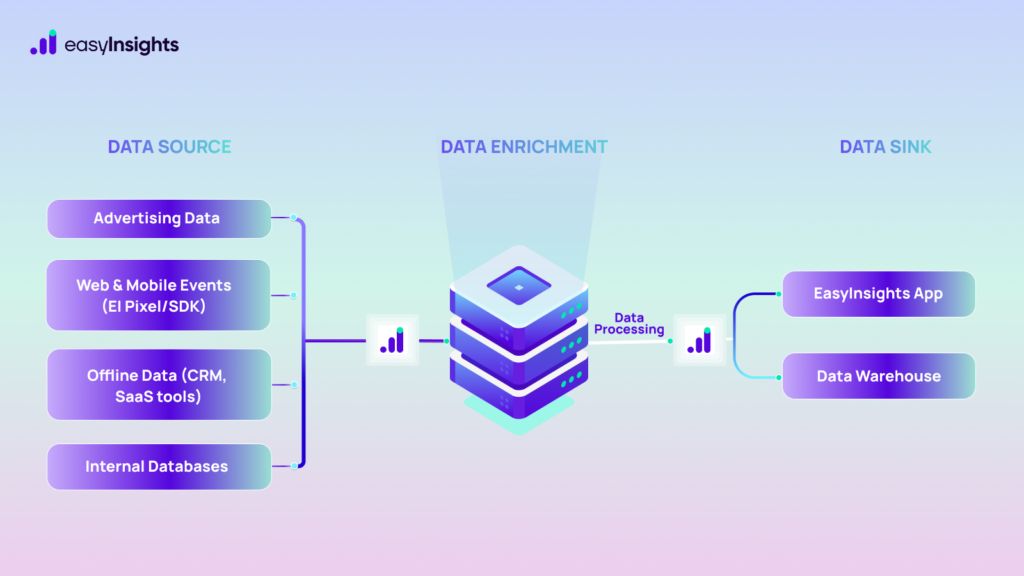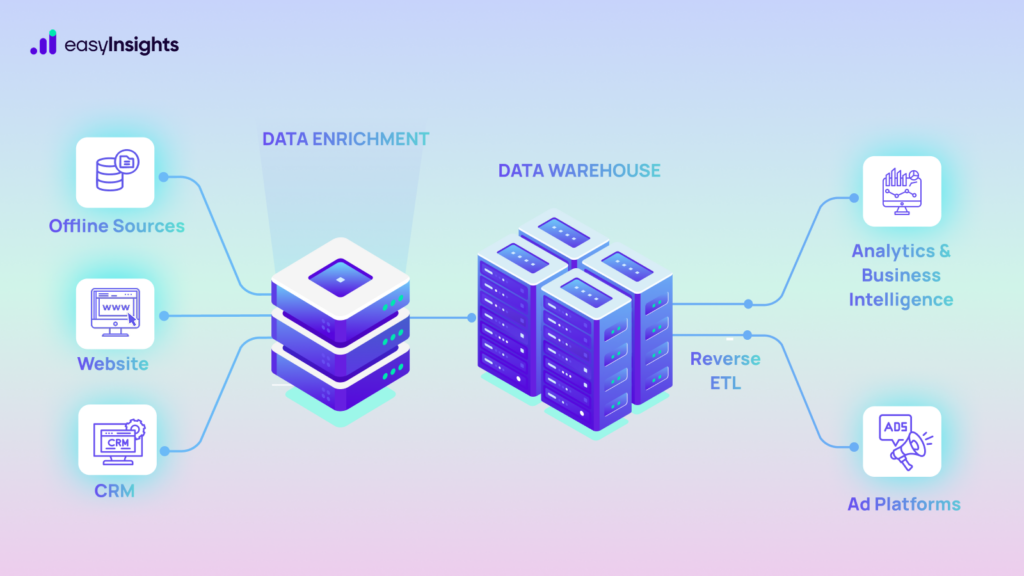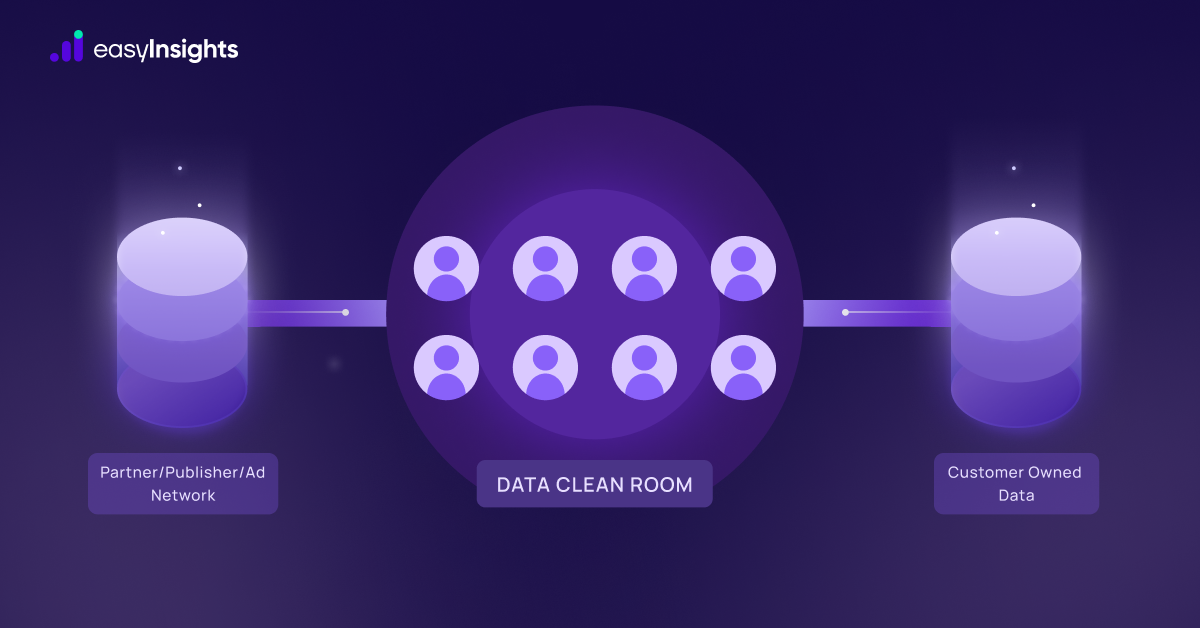
In today’s digital world, marketers are surrounded by data. Every time a customer clicks on an ad, visits a website, opens an email, or fills out a form, valuable information is generated. This data pours in from a variety of sources—Google and Meta Ads, CRM systems, website analytics tools like GA4, email platforms, and even offline channels like in-store visits or phone calls.
For growing businesses, the challenge isn’t collecting data—it’s bringing it all together. When information is scattered across different platforms, it becomes difficult to get a clear, unified view of what’s really working. Reports become messy, teams waste time switching between dashboards, and decisions are often made based on incomplete insights.
That’s where Marketing Data Warehouse becomes essential. It acts as a single home for all your marketing data, making it easier to organize, analyze, and act on. In the sections that follow, we’ll look at what exactly a centralized data warehouse is, why it’s critical for scaling brands and marketing teams.
Jump ahead to:
What is a Marketing Data Warehouse?
A Marketing Data Warehouse is a centralized system that collects, stores, and organizes marketing data from different sources in one place. Instead of jumping between multiple platforms (like Google Ads, Meta Ads, your website analytics, CRM, and email tools) – you get all your data in a single, structured database.
The warehouse doesn’t just store raw data, it also cleans, standardizes, and links it, so that your reports and dashboards are consistent, accurate, and useful.
Think of it like a digital filing cabinet, but smart: it automatically gathers data from everywhere, organizes it neatly, and makes it ready for analysis, reporting, or even sending back to ad platforms for optimization.
Key Features
1. Single Source of Truth
Different teams using different tools often leads to inconsistent data. A centralized warehouse unifies all sources, ensuring everyone, from analysts to executives to work with the same accurate numbers, improving trust and collaboration.
2. Cross-Channel Insights
Marketing spans many touchpoints like ads, emails, websites, and offline channels. A centralized system connects them, letting you see the complete customer journey and understand how each interaction influences conversions.
3. Scalability
As your marketing efforts grow, so does your data. Unlike spreadsheets or siloed tools, a data warehouse can handle high volumes efficiently, supporting everything from daily web traffic to multi-platform ad spend.
4. Security and Compliance
With increasing data privacy regulations, secure data management is critical. A centralized warehouse offers access controls, encryption, and audit trails, making it easier to stay compliant and govern sensitive information.
Data Funnel
A Marketing Data Warehouse helps teams collect, clean, store, and activate marketing data efficiently. It removes data silos, ensures consistency, and powers better decision-making. Here’s how the process works, step by step.

Data Collection (Ingestion)
The first step involves pulling raw data from a variety of sources across the marketing ecosystem.
Common data sources include:
- CRM platforms
- Commerce systems / source of truth
- Third-party checkout tools
- Offline sources (POS systems, in-store events, call center logs, etc.)
- Website and app analytics (via your own pixel or server-side tracking)
Data can be collected using:
- Batch Processing, which involves scheduled imports like daily or hourly file uploads.
- Real-Time Streaming, where data is captured instantly (e.g., tracking website clicks as they happen).
- API Integrations, which enable continuous data sync between tools and platforms.
Data Cleaning and Transformation
Raw data from different sources is often messy, inconsistent, or incomplete. Before it’s stored, it needs to be cleaned and transformed.
Cleaning typically involves:
- Deduplication, to remove duplicate entries.
- Error Correction, to fix missing or invalid values.
- Standardization, to ensure consistent formats for things like currencies, date fields, and naming conventions.
Transformation includes:
- Enrichment, by adding useful context such as customer segments or geographic data.
- Aggregation, which summarizes data (e.g., daily sales or weekly ad spend).
- Normalization, to structure data into a consistent format suitable for analysis.
Also Read: Using Data Enrichment to Improve Marketing Performance
Data Storage
After cleaning and structuring the data, teams store it in the warehouse, making it accessible for querying and analysis.
Storage options include:
- Cloud-based systems, which provide scalability, flexibility, and cost efficiency, ideal for growing teams and evolving data needs.
- On-premise setups, which offer greater control and may be preferred in industries with strict data compliance and security requirements.
The data is often organized using:
- Star Schemas, which connect fact tables (metrics like spend or conversions) with dimension tables (such as campaign names or regions).
- Data Lakes, which may be used to store unstructured data like logs, images, or raw event streams.
Data Analysis and Business Intelligence
With data stored and structured, marketing and analytics teams can use it to generate insights.
Common use cases include:
- Campaign performance reporting across channels.
- Customer segmentation, identifying high-value or churn-risk users.
- Forecasting models to predict future sales or optimize ad budgets.
Tools used: Business intelligence platforms such as Tableau, Power BI, and Looker, along with SQL for custom queries and dashboards.
Data Activation (Reverse ETL)
The insights don’t just stay in the warehouse—they’re pushed back into tools where action happens.
Data can be sent to:
- Ad platforms, to retarget high-intent users.
- Email and SMS tools, to trigger personalized communications.
- CRM systems, to update lead scores or enrich customer profiles.
This is enabled by reverse ETL platforms like EasyInsights.
Access Control and Security
Proper governance makes sure only the right people use the data carefully and responsibly.
- Role-based access control ensures that marketers, analysts, and external stakeholders only see what they need.
- Agencies and service providers can offer secure, permission-based access to client data through dedicated portals.
- To meet privacy regulations like GDPR and CCPA, marketers anonymize personal data and maintain audit trails.
Modern Data Warehouse: EasyInsights
What sets EasyInsights.ai apart is its ability to combine first-party data collection with server-side tracking, ensuring reliable data even in environments with ad blockers, cookie restrictions, or third-party limitations. This is especially valuable for brands with third-party checkouts or complex user journeys.
Once collected, EasyInsights cleans, enriches, and standardizes the data before pushing it into the marketing data warehouse—ensuring that what enters your reporting and BI tools is consistent, de-duplicated, and campaign-ready. This helps eliminate attribution gaps and reporting discrepancies at the source.
But EasyInsights doesn’t stop there. It also enables reverse data flows, sending enriched, accurately attributed events back from the warehouse to ad platforms like Meta and Google Ads. This allows campaign algorithms to learn from higher-quality signals, leading to better optimization, audience targeting, improved ROAS, and more efficient media spend.
In short, EasyInsights acts as both the gateway and the engine of a modern marketing data stack—bringing together tracking, warehousing, and activation in one powerful platform.
Also Read: Improve your Facebook (Meta) Event Match Quality Score
Conclusion
In today’s multi-channel marketing world, having accurate, unified data isn’t a luxury — it’s a necessity. A Marketing Data Warehouse helps growing brands cut through the noise, connect the dots, and make confident, insight-driven decisions. By centralizing, cleaning, and activating data, it turns raw numbers into real business value.
Platforms like EasyInsights take this a step further by not just organizing data, but also enhancing it — closing the loop between collection, reporting, and ad performance. For teams looking to scale smarter and get more from every marketing dollar, investing in a modern data warehouse is no longer optional — it’s foundational.
Book a demo, with EasyInsights today!






